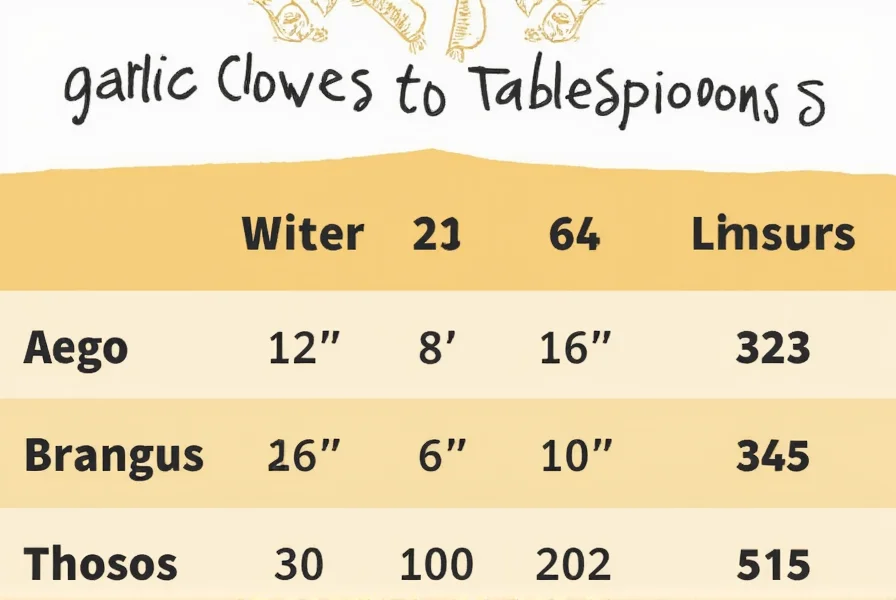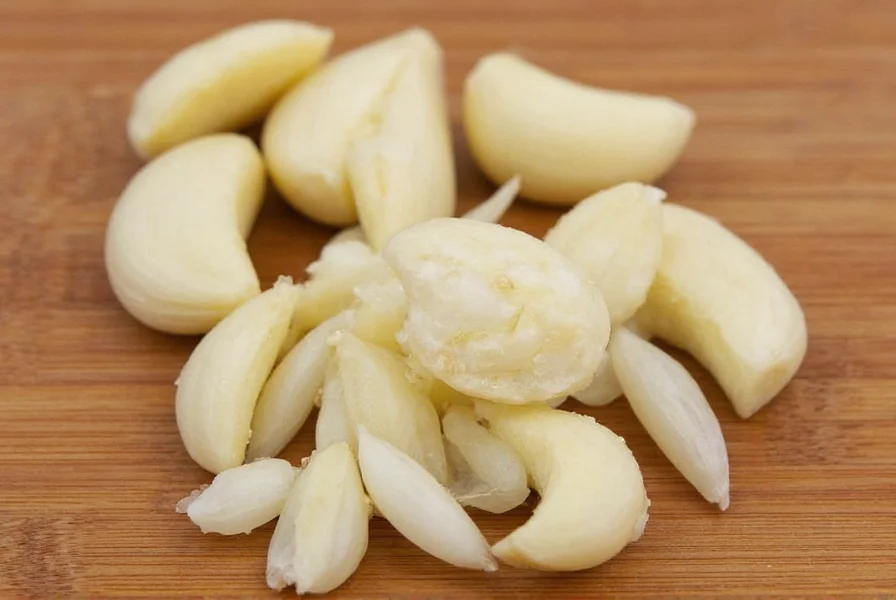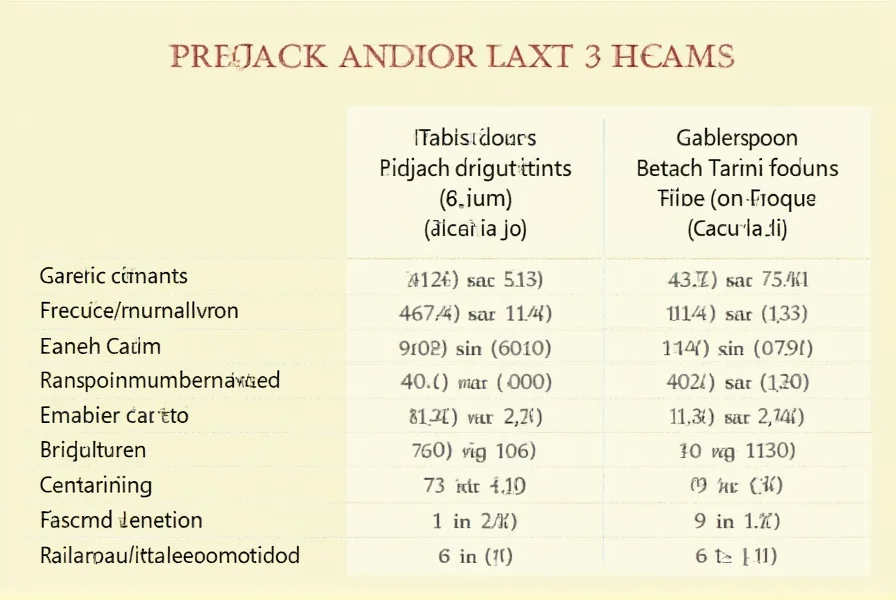Understanding garlic measurements is essential for achieving perfect flavor balance in your recipes. Many home cooks struggle with converting fresh garlic cloves to standardized tablespoon measurements, leading to inconsistent results in their cooking. This guide provides accurate conversions backed by culinary standards and practical kitchen experience.
Why Garlic Measurement Conversions Matter
Garlic's potent flavor can make or break a dish. Too little leaves recipes bland, while too much creates overpowering bitterness. Unlike dried spices, fresh garlic varies significantly in size and potency. A single clove from a supermarket bulb might contain half the volume of one from a farmer's market heirloom variety. This inconsistency makes tablespoon conversions crucial for recipe reliability.
Factors Affecting Garlic to Tablespoon Conversion
Three key variables impact your garlic clove to tablespoon conversion:
- Clove size: Commercial garlic typically has medium cloves (0.5"–0.7" diameter), while gourmet varieties range from petite (0.3") to jumbo (1"+)
- Preparation method: Minced garlic packs differently than pressed or roasted
- Moisture content: Freshly harvested garlic contains more water than cured bulbs
Standard Garlic Conversion Chart
| Garlic Cloves | Minced Garlic (Teaspoons) | Minced Garlic (Tablespoons) | Equivalent in Jarred Minced Garlic |
|---|---|---|---|
| 1 small clove (0.3"–0.4") | 3/4 tsp | 1/4 tbsp | 1/2 tsp |
| 1 medium clove (0.5"–0.7") | 1–1.5 tsp | 1/3–1/2 tbsp | 3/4 tsp |
| 1 large clove (0.8"–1.0") | 2–2.5 tsp | 2/3–5/6 tbsp | 1.5 tsp |
| 3 medium cloves | 3–4.5 tsp | 1 tbsp | 2.25 tsp |
| 6 medium cloves | 6–9 tsp | 2 tbsp (1/8 cup) | 4.5 tsp |

Practical Measurement Techniques
When converting cloves of garlic to tbsp in your kitchen, follow these professional techniques:
- For precision: Weigh cloves - medium cloves average 4–7 grams each
- For quick estimation: Remember that 3 medium cloves fill one tablespoon when finely minced
- When substituting jarred garlic: Use 1.5 times the fresh garlic measurement (jarred is more concentrated)
- For roasted garlic: One roasted medium clove equals 2 teaspoons (double the raw volume)
Common Measurement Mistakes to Avoid
Many home cooks make these critical errors when converting garlic measurement equivalents:
- Ignoring size variation: Using the same tablespoon measurement for elephant garlic (which can be 10x larger) as standard grocery store garlic
- Packing minced garlic: Pressing down creates false volume readings - minced garlic should be loosely measured
- Confusing volume with potency: Smaller, hotter garlic varieties need less volume for the same flavor impact
- Not accounting for preparation method: Pressed garlic yields less volume than hand-minced but has stronger flavor
When to Adjust Standard Conversions
Certain cooking scenarios require modifying standard garlic clove size to tablespoon ratio guidelines:
- Long-simmered dishes: Reduce garlic by 25% as flavors concentrate during cooking
- Raw applications (salad dressings, aioli): Increase by 20% since raw garlic has milder flavor
- With high-fat ingredients (cream, coconut milk): Increase by 15% as fat absorbs garlic compounds
- For sensitive palates: Start with 75% of standard measurement and adjust to taste

Professional Chef Tips for Garlic Measurement
Top culinary professionals use these advanced techniques for perfect substituting minced garlic for whole cloves:
- The finger test: A properly minced medium clove should fit on the tip of your index finger
- Water displacement: Drop cloves in water to measure exact volume before mincing
- Batch preparation: Mince multiple cloves at once for consistent texture and measurement
- Flavor calibration: Always taste after adding 75% of your calculated garlic, then adjust
FAQ: Garlic Measurement Questions
How many tablespoons is 4 garlic cloves?
Four medium garlic cloves equal approximately 1.5 tablespoons of minced garlic. For small cloves, use 1 tablespoon; for large cloves, measure 2 tablespoons. Always adjust based on your specific garlic variety and recipe requirements.
Can I substitute jarred minced garlic for fresh cloves?
Yes, but adjust measurements carefully. Use 1.5 times the amount of jarred garlic compared to fresh (e.g., where a recipe calls for 1 tablespoon fresh minced garlic, use 1.5 tablespoons jarred). Jarred garlic has higher water content and slightly different flavor profile, so taste and adjust as needed.
Does roasting garlic change the tablespoon conversion?
Yes, roasting significantly changes volume and potency. One roasted medium garlic clove yields about 2 teaspoons (2/3 tablespoon) of soft roasted garlic—double the volume of raw minced garlic. However, roasted garlic has milder flavor, so you may need to use more for equivalent taste impact.
How do I measure garlic cloves without a measuring spoon?
Use these practical methods: Three medium cloves should fill the hollow of your palm loosely. One tablespoon of minced garlic equals the size of a standard walnut. For smaller amounts, compare to coin sizes—1/2 tablespoon matches a quarter, 1 teaspoon fits on a nickel.
Why does my garlic measurement never match recipe results?
Garlic potency varies by season, variety, and storage conditions. Commercial garlic in winter tends to be stronger than summer garlic. Always start with 75% of the recommended amount, taste after 5 minutes of cooking, then adjust. This approach works better than strict tablespoon measurements for consistent results.











 浙公网安备
33010002000092号
浙公网安备
33010002000092号 浙B2-20120091-4
浙B2-20120091-4